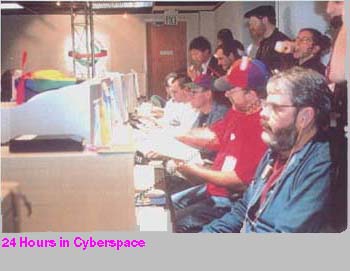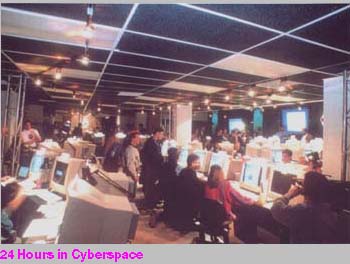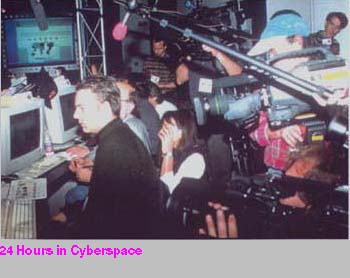 Bits and bytes on the World Wide Web provide an innovative
alternative to ink and paper for delivering news and analysis in the
information age. No doubt about it, the Web is revolutionizing the
publishing business.
Bits and bytes on the World Wide Web provide an innovative
alternative to ink and paper for delivering news and analysis in the
information age. No doubt about it, the Web is revolutionizing the
publishing business.
 Bits and bytes on the World Wide Web provide an innovative
alternative to ink and paper for delivering news and analysis in the
information age. No doubt about it, the Web is revolutionizing the
publishing business.
Bits and bytes on the World Wide Web provide an innovative
alternative to ink and paper for delivering news and analysis in the
information age. No doubt about it, the Web is revolutionizing the
publishing business.
What is the appeal of the Web for publishing ventures? Immediacy,
interactivity, and a very different cost structure. Electronic
publishing via the Web greatly reduces the start-up costs for a
publishing venture, and fundamentally alters the equation to sustain it
over time. This is especially true when leveraging an existing print or
broadcast product.
Newspapers, magazines, newsletters, broadcast journalism, and even photo journalism are scrambling to work out the kinks in this new medium. Some early Web ventures merely promote or slightly supplement an existing print or broadcast product. Increasingly, Web sites are standing on their own as publishing ventures, discrete from the traditional publishing venture that created them. Web-only publications are also springing up.
Web-based publishing is growing at a phenomenal pace. Take newspapers as an example. By the end of 1995, the number of papers tapping the Internet or on-line services tripled to 175, according the Newspaper Association of America. The total of all print publications on-line reached 775 by the end of last year.
Some publishers, such as the New York Times (www.nytimes.com) and the San Jose Mercury News (www.sjmercury.com), are considering charging a fee for access to deeper level archives. The daily newspaper is highly perishable, so there is a tremendous value-add to keeping content on-line for weeks or months, as disk space permits.
The Seattle Times (www.seatimes.com) is one of those papers to recently hop a ride on the InfoBahn. According to its executive editor and senior vice president, Michael Fancher, the paper's business strategy is two-fold -- defensive and active.
The defensive effort is focusing on getting its classified advertisers on the Web, and adding value for current display advertisers. To that end, the Seattle Times is not yet charging for classified ads.
"We want to send a message to the market that this is the business we own. We have the customer relations, and we intend to protect that franchise in electronic publishing," Fancher says.
The paper's active strategy is to leverage and extend its journalistic mission to serve the community, Fancher says, so early Web-publishing efforts are aimed at students and teachers.
The paper created two in-depth reports -- one on Martin Luther King Jr., and one on Trinity, the first nuclear explosion. Much more information is available electronically than ever made it to newsprint. Much more original source material was published. Study guides for students and teachers were published. And interactive elements are being added.
Unlike many, Fancher believes there is little value in reproducing the newspaper on its Web site. His vision is to grow content of his Web with more special reports, and news events to which the Web adds value to the reporting. For instance, Fancher says, the Web permits publishing the full text of a news conference together with a story. That is something a newspaper or magazine simply cannot afford to do.
One specific idea Fancher is kicking around is making the Seattle Times Web the world-wide authority for business coverage of Boeing and possibly Microsoft.
Forget the daily edition, says Colin Boatwright, NandO's director of development. Daily deadlines are artificial limitations imposed by printing presses and newsprint. Boatwright speaks proudly of instances where NandO pushed news stories out onto the Web immediately after an event.
"The Web lets us update a story whenever we need to, or to replace the top story with a bigger news event after the Web-based paper is published. You simply cannot do that with any print medium," Boatwright says.
NandO Times, formerly an offshoot of the Raleigh, N.C. News and Observer, does not share writers, editors, or photographers with any print publication, which Boatwright claims is crucial for evolving the unique Web-based publishing mindset -- immediacy and interactivity.
For instance, NandO prepared for the signing of the telecommunications act that recently passed the US Congress. As soon as the President touched ink to paper, NandO pushed pages onto its Web server. A critical editorial cartoon that may have violated portions of the controversial Internet Decency Act contained in the bill, commentary, and the news and further analysis of telecommunications reforms all went live on the Net as the act was signed into law.
NandO's innovative publishing model is paying dividends. A fifth Sun Web server and third T-1 connection are being added. Over the last year NandO Times has grown from 750,000 access hits per week to 7 million per week. And the venture is now attracting attention from deep-pocket advertising interests, Boatwright says.
Advertisers love interactive elements -- anything that moves or makes a noise, Boatwright says, so NandO is expanding the use of Java and Shockwave elements in its content. NandO is also putting the technology in place to rotate ads throughout NandO Times to guarantee advertisers are given maximum exposure, a flexibility that's not possible with a print publication.
Pathfinder publications are already capitalizing on the Web's strengths of immediacy and interactivity, says Dan Woods, an application engineer for the New York-based Pathfinder Web. Woods' charter is to determine how interactive elements add value to the content they publish.
Time, People, and Money magazines now publish daily news editions on the Web. Pathfinder sponsors on-line chats with newsmakers, financial analysts, entertainment personalities, and journalists.
The goal, Woods says, is "add more interactivity and personalize the content so that we can interact with users in a more meaningful fashion. We want to give users exactly what they want to see out of the huge data set that is available."
Cutting-edge print publication models are already doing some of that, notes Woods. Money mails one of five different publications to subscribers based upon their age and other demographics.
Java elements are now being used to put in more bells and whistles. Longer-term plans include providing applications, such as a personal money manager, that can be split off from the browser window.
Pathfinder's revenue-generation model focuses on advertising revenue, supplemented with some subscriber fees and sales of related merchandise -- mutual funds to Money readers, how-to books to those accessing This Old House, etc.
"This is the last year of big Web experiments. The stuff does not have to be profitable next year, but it has to clearly demonstrate the likelihood that it will be profitable at some definite time," Woods says.
Pathfinder went live in October 1994, and was generating 25 million hits a week one year later. With that growth curve, Woods is confident Web-based publishing is here to stay.
San Francisco-based Web Publishing Inc., a business unit of IDG Communications that owns more than 225 computer publications, recently followed its successful SunWorld Online (www.sun.com/sunworldonline/) with a second Web-only publishing venture, JavaWorld (www.javaworld.com). Michael McCarthy, the firm's president, says Web-based publishing turns the cost equation of a normal magazine on its head.
The six leading expenses of a traditional magazine, in order from largest to smallest, are paper to print it on, mailing costs, printing costs, content development or editorial costs, the cost of selling advertisements, and circulation development costs.
"Publishing on the Web immediately takes away more than half your costs," McCarthy says. "I think the costs of launching a Web-based magazine from scratch is two-thirds less than launching a print magazine."
That said, costs will shift around. It is going to cost more to get Web-savvy editorial and system staffers. Because an extra page of content does not have a high price tag, editorial costs may also rise due to the temptation to produce more content, and the desire to add interactive elements to the stories.
The cost of advertising sales will change dramatically, at least until the Web is a proven commodity to deep-pocket advertisers. Ad revenue will cost more to produce because Web-savvy sales people are more expensive, and they have to work a sale harder to produce results.
Web-based publishing ventures must also invest more in workstations, Web servers, and Internet connections. But as NandO's Woods notes, "At least I'm not paying for million-dollar printing presses."
McNeil-Lehrer Productions, producers of the PBS News Hour with Jim Lehrer, has launched the News Hour On-line Web site (www.pbs.org/newshour/).
"This isn't a warmed-over news broadcast crammed onto the Web," says Dan Werner, a vice president with McNeil Lehrer. "There is no question that we are leveraging the content of the News Hour broadcast, but it is much more than that."
After only two months, the News Hour On-line is weaving interview and discussion transcripts into background briefing papers, and on-line forums enable readers to e-mail their comments and analysis, which is then posted to the Web.
The News Hours strength is substantive analysis, Werner says, and so far "a steady stream of e-mail indicates we are engaging people, whether they watch the show or not, and that's the most important thing."
The Sun-based Web infrastructure now offers Real Audio, and with the help of PBS is developing a search engine implementation.
To support the publishing venture over the long haul, Werner expects they will stay with the funding model they know best -- underwriter funding. Somewhere in PBS' future it may have to wrestle with subscription fees or advertising, but Werner doesn't plan to set that precedent with this Web site.
The Web is not only revolutionizing publishing economics, and bringing more immediacy and interactivity to the content produced, it is also revolutionizing the process. A particularly innovative example was San Francisco-based Against All Odds Products foray into participatory, near real-time photo journalism.
 Ten years after the ground-breaking A Day In The Life of
America, a book of photographs taken within a 24-hour period
throughout the US, the same team took to the Internet to produce 24
Hours In Cyberspace
(www.cyber24.com).
More than 50 SPARC workstations, and software from Adobe Systems,
Netscape Communications, and others, provided the infrastructure to
document the human face of the global Internet. About 150 top photo
journalists, hundreds of amateur photographers, and scores of editors
on loan from magazines and newspapers, collaborated to photograph and
publish 24 Hours In Cyberspace in near real-time fashion, says
Patti Richards, a project spokesperson.
Ten years after the ground-breaking A Day In The Life of
America, a book of photographs taken within a 24-hour period
throughout the US, the same team took to the Internet to produce 24
Hours In Cyberspace
(www.cyber24.com).
More than 50 SPARC workstations, and software from Adobe Systems,
Netscape Communications, and others, provided the infrastructure to
document the human face of the global Internet. About 150 top photo
journalists, hundreds of amateur photographers, and scores of editors
on loan from magazines and newspapers, collaborated to photograph and
publish 24 Hours In Cyberspace in near real-time fashion, says
Patti Richards, a project spokesperson.
 The instant Web site evolved throughout the 24-hour period as shots
from 250 photo assignments were digitally transmitted to mission
control in the Bay area.
The instant Web site evolved throughout the 24-hour period as shots
from 250 photo assignments were digitally transmitted to mission
control in the Bay area.
"This was fundamentally different from all the "Day In The Life" projects we've done in the past," Richards says. "With 24 Hours In Cyberspace, it was incredibly intense. We were shooting, editing, and publishing all at the same time."
The instant Web site produced February 8th is being transformed into a permanent site scheduled to debut March 17th. Later in the year, the more traditional book form of the event will be published.
Just like the paperless office, forecasted in the early and mid-1980's, but which failed to materialize, the power of the Web will not displace traditional publishing. It is clear, however, that the Web provides a powerful infrastructure for alternative publishing channels.
Resources
URL: http://kaiser/mark/CatalystPublishing.html
March 8, 1996